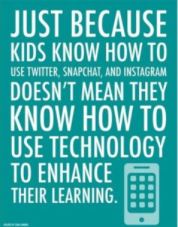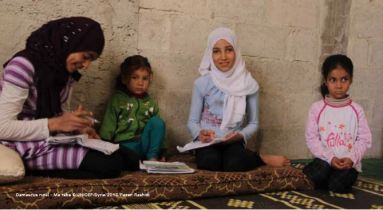The eSpace provides an opportunity for children to access their education via their mobile device.
According to research of young people in 2015 on the use of technology in the Zaatari Refugee Camp:
- 86% own a mobile device
- over 50% use the internet at least once per day
- there is a high level of interest in social media and news (Koons, 2015)
Families can benefit from technology that is available to facilitate and enhance their child/ren’s learning.
Unicef’s Regional Education Advsier, Dina Craisati identified that technology can potentially assist in providing an education solution for Syrian refugee children.
It is important that when young people are starting to utilise their mobile devices for learning that educators together with parents:
- develop a plan as to how their devices are going to be utilised
- develop a strategy for teaching their students how to use technology to assist in their journey of learning and not to just find the answers, and
- to remember that:
 (Schoenbart, 2016)
(Schoenbart, 2016)
 Click the image to learn about the many challenges facing young people trying to gain an education in the Zaatari Refugee Camp.
Click the image to learn about the many challenges facing young people trying to gain an education in the Zaatari Refugee Camp.
Opportunities for children for an Educator to come to where they are….
One of the opportunities that has been recognised is for young people who can’t attend school in the camp is to have a ‘school’ that can travel with the children, no matter where they are so that children can continue their education.
If a young person can’t attend school, then school could come to the student through the eSpace and through the support of an Educator.
 (Unicef, 2016)
(Unicef, 2016)
An opportunity presents itself for teachers living in the Refugee camp – to teach students at night time or on weekends. The teachers could be registered teachers themselves living as refugees in Zaatari or could be from the 9 schools in the camp. The teachers could come into the student’s home for 2 hours once or twice a week.
The teachers could be volunteers or they could receive a wage, possibly through the UNHCR’s Cash for Work programme where Education is funded through the UNHCR and supporting partners in the Zaatari Refugee Camp.
It is important that teachers are supported when visiting a child’s family home. This could be provided by the UNHCR Education Working Group .
It will be ideal if teachers and educators receive professional development before setting up a programme to assess the learning needs of each child. Teachers will also need to know how to support students with potential mental, emotional along with physical health issues.
Resources for young people and their families
After teachers leave the students they can set the students tasks that they can complete with their family members during the week before their next visit. Click on each image below for e-learning programmes for students.
 War Child- Can’t wait to Learn is an eLearning programme that is being trialled in Sudan and is being adapted for the children in Syria. It is based on the principle that children can learn, even without the support of teachers. The programme is delivered via tablet computers where children learn through playing online educational based games.
War Child- Can’t wait to Learn is an eLearning programme that is being trialled in Sudan and is being adapted for the children in Syria. It is based on the principle that children can learn, even without the support of teachers. The programme is delivered via tablet computers where children learn through playing online educational based games.
 Little Thinking Minds is an Arabic digital based online programme that provides culturally specific content for children under 7 based around literacy, numeracy and art.
Little Thinking Minds is an Arabic digital based online programme that provides culturally specific content for children under 7 based around literacy, numeracy and art.
![]() Study Ladders is an online programme targeted at primary school aged children for literacy and mathematics, languages (including Arabic), science, ICT, Health and safety, music and art.
Study Ladders is an online programme targeted at primary school aged children for literacy and mathematics, languages (including Arabic), science, ICT, Health and safety, music and art.
![]() Skoolbo is an online resource to assist children’s literacy and numeracy skills. Teachers are able to incrementally build on activities for their students based on their student’s own needs and abilities.
Skoolbo is an online resource to assist children’s literacy and numeracy skills. Teachers are able to incrementally build on activities for their students based on their student’s own needs and abilities.
 ABCya provides free educational computer games and mobile apps designed by teachers for primary school aged children focussing on literacy, numeracy, social studies and art.
ABCya provides free educational computer games and mobile apps designed by teachers for primary school aged children focussing on literacy, numeracy, social studies and art.
Teachers could also set up ![]() for their students. Wikispaces could provide opportunities for teachers to set up virtual classrooms for students in Zaatari. Students could collaborate on projects with each other and their teacher during the week and receive feedback without the teacher physically being present. Students can also assist each other with their work.
for their students. Wikispaces could provide opportunities for teachers to set up virtual classrooms for students in Zaatari. Students could collaborate on projects with each other and their teacher during the week and receive feedback without the teacher physically being present. Students can also assist each other with their work.
“The School in the Cloud…helps students prepare for the future by using Self Organised Learning Environments” (2016)
The number of teachers and educators visiting students in their own home is a limited resource in the Zaatari Refugee Camp.
Young people could continue their education through the School in the Cloud where students talk to their teacher via a virtual classroom.
The teacher is known as a Granny in the Cloud. The Granny talks to the children through a Skype Camera and asks the students open ended questions which challenge and guide the students learning. The Grannies receive support through the School in the Cloud Network.
The programme of work for each child could be worked in collaboration with the School in the Cloud network along with the Jordan Education Sector Working Group to make sure the learning needs of the young person is met.
The School in the Cloud lessons could take place one-on-one with the Granny and the person in their home. Or several young people could gather in one of their homes or a safe community space within walking distance of each of their homes to be taught through School in a Cloud.
The Granny could set specific tasks for the students to work on prior to the next lesson. Students could be left with a question and then told to come back to share their answer in a week’s time. They could explore the concepts and follow up…for example – How does a mobile phone know where it is?
Teachers can watch this video to learn more about the opportunities School in a Cloud offers students, regardless of where they live….
(TED, 2013)
Young people learning coding
SAP and universities in the Middle East are joining with UNHCR to offer opportunities for teaching young people programming and coding. It assists students to learn market-ready coding skills.
The video below highlights the opportunities for coding for teachers and students in the camp:
Teachers can access more information on code week via the website or ![]()
![]() Click on the button to to go to Beyond the Classroom Learning Space page.
Click on the button to to go to Beyond the Classroom Learning Space page.
![]() Click on the button to go to visit the Mission and Vision page.
Click on the button to go to visit the Mission and Vision page.
____________________________________________________________________
References:
Koons, S, 2016. IST researchers explore technology use in Syrian refugee camp. Retrieved from: http://news.psu.edu/story/350156/2015/03/26/research/ist-researchers-explore-technology-use-syrian-refugee-camp
Miels-Barrett, B, 2016. The strengths and challenges for Teachers in creating the eSpace. Retrieved from: Creating learning spaces in our school. Retrieved from:
Newcastle University, 2016. School in the Cloud. Retrieved from: https://www.theschoolinthecloud.org/
Schoenbart, A. (2016). Do we need to teach students to use technology? Retrieved from http://www.techlearning.com/blogentry/11207
TED, 2016. Sugata Mitra: Build a School in the Cloud. Retrieved from: https://www.youtube.com/watch?v=y3jYVe1RGaU&feature=youtu.be
UNICEF, 2014. Lebanon: A tiny computer lets Syrian refugees learn. Retrieved from: https://www.youtube.com/watch?v=qe0ab0n13Rk
Unicef, 2016. Photograph – Children going to school in their own home. Retrieved from:http://wos-education.org/uploads/self-learning_materials/without_logo/Self_learning_brief_note_Spread_English.pdf
United Nations High Commissioner for Refugees, October 2016. Twitter Zaatari Home Page. Retrieved from: https://twitter.com/ZaatariCamp
United Nations High Commissioner for Refugees, October 2016. Zaatari Refugee Camp Fact Sheet – October 2016. Retrieved from: http://data.unhcr.org/syrianrefugees/settlement.php?id=176®ion=77&country=107
United Nations High Commissioner for Refugees, October 2016. Syria Regional Refugee Response: Inter-agency Information Sharing Portal: Zaatari Refugee Camp. Retrieved from: http://data.unhcr.org/syrianrefugees/settlement.php?id=176®ion=77&=107
U.S. Department of Health & Human Services. 2016. What is Cyberbullying, Retrieved from: https://www.stopbullying.gov/cyberbullying/what-is-it/

